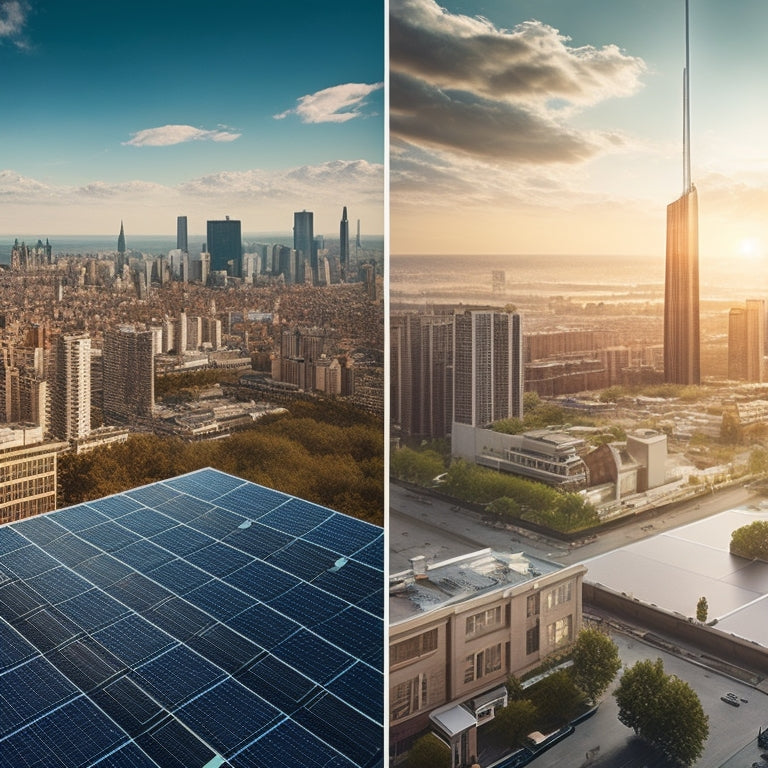
Compare Residential Solar Panel Efficiencies Online
Share
When comparing residential solar panel efficiencies online, you're likely looking to maximize your energy savings and environmental impact. High-efficiency models from top brands like SunPower, Panasonic, and LG boast ratings up to 23.6%. To make an informed decision, consider factors affecting efficiency, such as temperature coefficients and operating temperature range. You'll also want to evaluate metrics like peak sun hours, local conditions, and module efficiency rate. With the right tools and knowledge, you can navigate the market and find the perfect fit for your needs. Now, explore further to uncover the best solution for your energy goals.
Key Takeaways
• Compare top brands like SunPower, Panasonic, and LG to find high-efficiency models that reduce reliance on the grid and lower electricity bills.
• Analyze efficiency charts and consider factors like warranty, durability, and certifications to make informed decisions.
• Online navigation enables easy comparisons and personalized recommendations to find the best solar panels for your needs.
• Efficiency metrics to consider include peak sun hours, local conditions, and module efficiency rate to optimize energy output potential.
• Balance efficiency, cost, warranty, durability, and certifications to select the right solar panels for your residential needs.
Understanding Solar Panel Efficiency
You're likely familiar with the concept of efficiency in everyday devices, but when it comes to solar panels, understanding how effective they're is essential to maximizing your renewable energy output.
A solar panel's efficiency rate determines how much electricity it can generate from the sun's energy. A higher efficiency rate means more energy savings for you. When choosing a solar panel, look for high-efficiency models to reap the most benefits.
Higher efficiency solar panels can provide significant Energy Savings over their lower-efficiency counterparts. By harnessing more energy from the sun, you can reduce your reliance on the grid and lower your electricity bills. This not only saves you money but also contributes to a cleaner environment.
The Green Benefits of solar energy are undeniable, and optimizing your solar panel's efficiency is vital to minimizing your carbon footprint. By understanding solar panel efficiency, you can make informed decisions when selecting the right system for your home, ensuring you maximize your renewable energy output and reap the benefits of going green.
Online Comparison Made Easy
With online comparison tools, finding the most efficient solar panels for your residential needs becomes a streamlined process, allowing you to weigh the pros and cons of different models and make an informed decision. You can easily navigate through various options, filtering by efficiency ratings, prices, and features that matter most to you.
Here are some benefits of using online tools for comparison:
-
Easy navigation: Quickly browse through a vast selection of solar panels, filtering by efficiency ratings, prices, and features that matter most to you.
-
Side-by-side comparisons: Directly compare the specifications and features of different models, making it easy to identify the best fit for your needs.
-
Unbiased reviews: Read reviews from other customers who've installed the same solar panels, giving you a realistic understanding of their performance.
-
Real-time pricing: Get accurate and up-to-date pricing information, ensuring you get the best deal possible.
-
Personalized recommendations: Some online tools even offer personalized recommendations based on your specific energy needs and roof size.
Top Brands and Their Ratings
Frequently, homeowners seeking high-efficiency solar panels turn to top brands that have consistently delivered exceptional performance and reliability, with ratings that reflect their superior quality. You're likely familiar with names like SunPower, Panasonic, and LG, which have established themselves as industry leaders. These brands have earned their reputation through thorough testing, innovative designs, and extensive solar warranties that provide assurance for your investment.
When you choose a top brand, you're more likely to experience brand loyalty, as their products are designed to meet your energy needs for years to come.
For instance, SunPower's X-Series residential solar panels boast an impressive 22.8% efficiency rating, making them an attractive option for homeowners seeking maximum energy production. Meanwhile, Panasonic's HIT-240 panels offer a 21.8% efficiency rating, along with a 25-year warranty that provides added peace of mind.
Factors Affecting Efficiency Ratings
When delving into the realm of residential solar panels, it's crucial to take into account the factors that impact efficiency ratings.
You'll discover that cell temperature coefficients, reflection, and absorption play significant roles in determining a panel's overall efficiency.
Cell Temperature Coefficients
Your solar panel's efficiency rating can be greatly influenced by its cell temperature coefficient, which measures how well it performs under elevated temperatures. As temperatures rise, your panel's efficiency can drop considerably, reducing the amount of power it can generate. This is because high temperatures can cause the semiconductor material in the cells to become less efficient.
Here are some key factors to take into account when evaluating a solar panel's cell temperature coefficient:
-
Heat Resistance: Look for panels with high heat resistance to minimize efficiency losses under high temperatures.
-
Thermal Expansion: Make sure the panel's materials are designed to handle thermal expansion, reducing stress on the system.
-
Temperature Range: Check the panel's operating temperature range to make sure it can handle your local climate.
-
Performance Warranty: Review the warranty's temperature-related performance guarantees.
-
Datasheet Specifications: Verify the panel's temperature coefficient specifications in the datasheet.
Reflection and Absorption
When evaluating a solar panel's efficiency, it's also important to take into account how much sunlight is lost due to reflection and absorption, as these factors can greatly impact the panel's overall performance.
You should consider that some sunlight is reflected off the panel's surface, rather than being absorbed and converted into energy. This is known as light scattering, and it can reduce the panel's efficiency by up to 5%.
Additionally, some sunlight is absorbed by the panel's materials, generating heat rather than electricity. This heat absorption can further decrease the panel's efficiency, especially in high-temperature environments.
To minimize these losses, manufacturers often apply anti-reflective coatings to reduce light scattering and use materials with high thermal conductivity to dissipate heat. You can look for panels with high-quality coatings and materials to minimize reflection and absorption losses.
Efficiency Metrics to Consider
As you evaluate residential solar panels, you'll encounter various efficiency metrics that can impact your system's performance. You should understand the significance of peak sun hours, which measures the amount of solar energy available at your location, and the module efficiency rate, which indicates how well a panel converts sunlight into electricity.
Peak Sun Hours
Measuring peak sun hours (PSH) helps you determine the amount of solar energy your location receives, which greatly impacts the efficiency of your residential solar panel system. As you compare residential solar panel efficiencies online, understanding PSH is vital.
Peak sun hours represent the amount of solar irradiance your location receives in a day, which varies depending on climate variability.
Here are key factors to take into account when evaluating PSH:
-
Latitude and Altitude: Locations closer to the equator receive more solar irradiance, while higher elevations receive more intense sunlight.
-
Seasonal Variations: Summer months typically receive more solar energy than winter months.
-
Cloud Cover and Shade: Obstructions like clouds, trees, and buildings reduce PSH.
-
Atmospheric Conditions: Air pollution, humidity, and temperature affect solar irradiance.
-
Local Topography: Mountainous or coastal regions may receive less solar energy due to shadows and reflections.
Module Efficiency Rate
You'll want to take into account the module efficiency rate, which represents the percentage of sunlight that's converted into electrical energy, when evaluating the performance of residential solar panels. This metric is important in determining the amount of energy your solar panel system can produce. A higher module efficiency rate means more energy harvesting and increased power density.
Here's a comparison of popular residential solar panels by module efficiency rate:
| Solar Panel Model | Module Efficiency Rate (%) |
|---|---|
| Panasonic HIT-240 | 21.8 |
| SunPower X-Series | 22.2 |
| Tesla Solar Roof | 20.5 |
| LG NeON 2 | 20.3 |
| Trina Solar Tallmax M10 | 19.9 |
When choosing a residential solar panel, consider a module efficiency rate of at least 20% for best energy harvesting and power density. Keep in mind that higher efficiency rates often come with a higher price tag. However, if you're looking to maximize your energy output, investing in a high-efficiency solar panel may be worth the extra cost.
How to Read Efficiency Charts
Efficiency charts often plot module efficiency against temperature, and understanding how to decipher these charts is essential for selecting the right solar panel for your residential needs. You'll want to analyze the chart patterns to identify the best operating conditions for your solar panel.
To effectively read efficiency charts, keep the following key points in mind:
-
Identify the x-axis: Typically representing temperature, this axis shows how efficiency changes with rising temperatures.
-
Analyze the curve: Note the pattern of the efficiency curve, which can be linear, logarithmic, or exponential, to understand how efficiency changes with temperature.
-
Look for peak efficiency: Identify the temperature at which the solar panel achieves its highest efficiency.
-
Check for temperature coefficients: These indicate how efficiently the panel performs at higher temperatures.
-
Compare charts: Analyze multiple charts to compare the performance of different solar panels under various temperature conditions.
Residential Solar Panel Options
When choosing a residential solar panel, you're faced with a multitude of options, each boasting unique features, benefits, and efficiencies. You'll want to take into account factors such as panel type, wattage, and warranty when selecting the best option for your home.
Additionally, you may be eligible for Solar Incentives, which can greatly reduce the upfront cost of installation.
As you navigate the various residential solar panel options, consider integrating Home Automation systems to optimize energy production and consumption. This can include smart inverters, energy monitoring systems, and smart home devices that allow you to control and monitor your energy usage remotely.
When evaluating options, prioritize your energy needs and budget to make sure you're getting the most efficient system for your home. Be sure to research and compare different manufacturers, as well as local and national incentives, to maximize your investment.
Comparing Mono Vs Poly Panels
Your solar panel selection hinges on a critical distinction: monocrystalline (mono) versus polycrystalline (poly) panels, each with its own strengths and weaknesses. As you weigh your options, consider the following key differences:
-
Efficiency: Mono panels boast higher efficiencies (15-20%) due to their single-crystal structure, while poly panels have lower efficiencies (12-15%) due to their multi-crystal structure.
-
Cost effectiveness: Poly panels are generally cheaper to produce, making them a more affordable option for those on a budget.
-
Space constraints: Mono panels are more space-efficient, making them ideal for smaller rooftops or areas with limited space.
-
Durability: Both types have similar lifespans (25-30 years), but mono panels tend to be more resistant to heat and degradation.
-
Aesthetics: Mono panels have a sleeker, more uniform appearance, while poly panels have a more speckled, blue-ish hue.
When choosing between mono and poly panels, consider your specific needs and priorities. If cost-effectiveness is key, poly panels might be the way to go. However, if you're willing to invest in higher efficiency and sleeker aesthetics, mono panels could be the better choice.
Maximizing Energy Output Potential
When it comes to maximizing your solar panel's energy output potential, you'll want to focus on three key factors.
First, you'll need to guarantee your panels are positioned at ideal angles to capture the most sunlight.
Optimal Panel Angles Matter
By positioning your solar panels at a favorable angle, you can greatly enhance their energy output potential, as even a slight deviation from the ideal angle can result in substantial energy losses. This is especially important considering the significant impact of roof orientation on energy production.
For instance, a south-facing roof with an angle between 30° to 40° is often considered ideal, but this may vary depending on your location and seasonal variations.
To maximize energy output, consider the following factors when determining the best angle for your solar panels:
-
Latitude and climate: Adjust the angle based on your location's latitude and climate to ensure efficient energy harvesting.
-
Roof orientation: Ensure your solar panels are installed on a roof with a favorable orientation, taking into account any obstructions or shading.
-
Seasonal variations: Consider the changing angle of the sun throughout the year to optimize energy production during peak seasons.
-
Panel type and efficiency: Choose a high-efficiency panel that can perform well at a range of angles, and consider the panel's temperature coefficient.
-
Local building codes and regulations: Comply with local regulations and building codes when installing your solar panels at the best angle.
High-Efficiency Cell Technology
Optimizing panel angles is just the starting point, as the type of solar cells used in your panels also has a substantial impact on energy output, and high-efficiency cell technology can maximize your energy harvesting potential.
You see, traditional solar panels use silicon wafers with an efficiency rate of around 15-18%. However, high-efficiency cells can boost this rate to 20-22% or more. This increase in efficiency translates to more energy harvested from the same amount of sunlight.
High-efficiency cells achieve this by using advanced materials and designs, such as multi-junction cells or bifacial cells. These innovations enable your solar panels to convert a higher percentage of sunlight into usable electricity. As a result, you'll generate more power from the same roof or ground space.
When comparing solar panels, look for high-efficiency cell technology to maximize your energy output. By doing so, you'll be able to harness more energy from the sun, reducing your reliance on the grid and your carbon footprint.
Peak Sun Hours Count
You can greatly enhance your solar panel's energy output by understanding and maximizing peak sun hours count, which refers to the amount of solar energy available at a given location. This measure is important since it directly affects the performance of your solar panel system.
Peak sun hours represent the amount of solar irradiance your location receives daily, influencing your system's energy output.
To optimize your solar panel's performance, consider the following factors that impact peak sun hours:
- Latitude and longitude: Locations closer to the equator receive more direct sunlight, resulting in higher peak sun hours.
- Seasonality: Peak sun hours vary throughout the year, with more hours during summer and fewer during winter.
- Shading and obstruction: Trees, buildings, or other obstructions can reduce peak sun hours by blocking sunlight.
- Atmospheric conditions: Air pollution, humidity, and cloud cover can scatter or absorb sunlight, decreasing peak sun hours.
- Panel orientation and tilt: Properly angled and tilted panels can maximize peak sun hours by receiving more direct sunlight.
Making an Informed Purchase Decision
When evaluating solar panel systems, it is important to take into account several key factors to guarantee you're making an informed purchase decision that aligns with your energy needs and budget. You must consider your budget constraints, as solar panels can be a significant investment. Be wary of sales tactics that might oversell the benefits of a particular system. Instead, focus on the key performance indicators that matter most to you.
| Factor | Considerations |
|---|---|
| Efficiency | Higher efficiency means more power per unit area |
| Warranty | Look for extensive warranties that cover parts and labor |
| Durability | Assess the panel's durability and resistance to environmental stress |
| Certifications | Ensure the system meets local and national certifications |
| Installation | Consider the installation process, including permits and labor costs |
Frequently Asked Questions
Can Solar Panels Be Installed on a Metal Roof?
You can install solar panels on a metal roof, but you'll need to make sure the roofing material is solar-friendly, such as standing-seam or corrugated metal, and use compatible mounting systems to secure the panels.
Do Solar Panels Work During a Power Outage?
You might be surprised to know that 72% of Americans consider energy independence important. During a power outage, your solar panels won't provide backup power unless you have a battery storage system, allowing you to achieve grid independence.
Are Solar Panels Affected by Shade From Trees?
You'll find that solar panels are greatly affected by shade from trees, particularly when tree canopies create complex shading patterns that reduce energy output, making it essential to assess and mitigate shading effects for best performance.
Can I Install Solar Panels Myself to Save Money?
'Carefully consider conquering the complexities of solar panel installation yourself to cut costs. However, you'll need to navigate nuanced DIY permits and research local incentives to guarantee a successful, savings-driven setup.'
Will Solar Panels Increase My Property Value?
You'll likely see an appraisal impact, as solar panels boost your property value, providing a resale advantage; in fact, studies show an average increase of $15,000 to $20,000 in resale value, making your home more attractive to potential buyers.
Related Posts
-

7 Best Home Electric Vehicle Charging Station Setups
When selecting a home electric vehicle charging station setup, consider a Level 2 charging station with a dedicated 4...
-

7 Essential Tips to Buy Discounted Solar Panels Online
When purchasing discounted solar panels online, you'll want to research top brands like SunPower, Panasonic, and LG, ...
-

5 Best Online Stores for Green Vehicle Solutions
You're on the hunt for an eco-friendly ride, and online stores are a great place to start. You'll find top retailers ...


